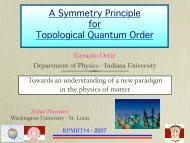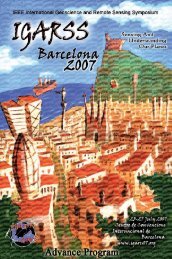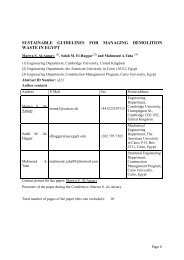innovative fe-analysis of the roller burnishing process for different ...
innovative fe-analysis of the roller burnishing process for different ...
innovative fe-analysis of the roller burnishing process for different ...
Create successful ePaper yourself
Turn your PDF publications into a flip-book with our unique Google optimized e-Paper software.
F. Klocke, V. Bäcker, H. Wegner and A. Timmer.<br />
In order to provide a quantitative comparison <strong>of</strong> <strong>the</strong> simulated and experimental results,<br />
this evaluation methodology was applied. The results <strong>of</strong> this comparison are shown<br />
exemplarily <strong>for</strong> <strong>the</strong> <strong>roller</strong> <strong>burnishing</strong> <strong>of</strong> Ti-6Al-4V (Figure 3). They achieve generally a very<br />
good correlation between calculated and measured results <strong>for</strong> all geometries.<br />
The distribution <strong>of</strong> <strong>the</strong> residual stresses <strong>for</strong> thin walled geometries dif<strong>fe</strong>rs significantly<br />
from <strong>the</strong> stress distribution observed and calculated <strong>for</strong> plane geometry, which is af<strong>fe</strong>cted<br />
only in <strong>the</strong> rime zone <strong>of</strong> <strong>the</strong> <strong>process</strong>ed surface. Thin walled geometries are influenced over<br />
<strong>the</strong>ir complete thickness. Due to <strong>the</strong> <strong>roller</strong> <strong>burnishing</strong> <strong>process</strong>, negative residual stresses are<br />
induced in <strong>the</strong> rime zone. These stresses are compensated by positive residual stresses in <strong>the</strong><br />
inner part <strong>of</strong> <strong>the</strong> workpiece.<br />
The contour plot <strong>of</strong> <strong>the</strong> residual stress in <strong>the</strong> simulation using curved geometry shows that<br />
<strong>the</strong> <strong>roller</strong> <strong>burnishing</strong> <strong>process</strong> does not induce stresses only in <strong>the</strong> <strong>process</strong>ed curved zone. The<br />
stress induction is extended to <strong>the</strong> adjacent plane areas.<br />
4 CONCLUSIONS<br />
The high stress gradients in <strong>the</strong> rime zone after <strong>roller</strong> <strong>burnishing</strong> require fine meshing <strong>of</strong><br />
this area, which limits <strong>the</strong> model size and renders a macro-modelling <strong>of</strong> <strong>the</strong> <strong>roller</strong> <strong>burnishing</strong><br />
<strong>process</strong> as time-inefficient or even impossible. The model simplifications and <strong>the</strong> assumptions<br />
made in <strong>the</strong> modelling phase cause additional scatter to <strong>the</strong> numerical errors and have to be<br />
chosen carefully. A quantitative prediction <strong>of</strong> <strong>the</strong> residual stress state <strong>of</strong> <strong>the</strong> rime zone<br />
requires a sophisticated and representative validation strategy based on statistically firm<br />
evaluation <strong>of</strong> <strong>the</strong> model results, which is what <strong>the</strong>se FE-models achieve. All developed FEmodels<br />
were validated and are able to predict <strong>the</strong> residual stress state after <strong>roller</strong> <strong>burnishing</strong><br />
with sufficient accuracy.<br />
5 AKNOWLEDGEMENT<br />
The authors gratefully acknowledge <strong>the</strong> financial support from <strong>the</strong> European 6th<br />
Framework Programme through <strong>the</strong> research project VERDI (Virtual Engineering <strong>for</strong> Robust<br />
Manufacturing with Design Integration; http://www.verdi-fp6.org).<br />
REFERENCES<br />
[1] C. Achmus, Messung und Berechnung des Randschichtzustands komplexer Bauteile nach dem Festwalzen,<br />
PhD-Thesis, TU-Braunschweig, 1999<br />
[2] G. Berstein, G. Fuchsbauer, Festwalzen und Schwing<strong>fe</strong>stigkeit, Werkst<strong>of</strong>ftechnik, Vol. 13, 1982<br />
[3] U. Jung, FEM-Simulation und experimentelle Optimierung des Festwalzens bauteilähnlicher Proben<br />
unterschiedlicher Größen, PhD-Thesis, TU Darmstadt, 1996<br />
[4] S. Mader, Festwalzen von Fan- und Verdichterschau<strong>fe</strong>ln, PhD-Thesis, RWTH Aachen, 2007<br />
[5] T. Oppermann, Beitrag über die Schwing<strong>fe</strong>stigkeitssteigerung in Wöhler- und Betriebs<strong>fe</strong>stigkeitsversuchen<br />
durch Reinigungsstrahlen und Festwalzen konventionell und vereinfacht wärmebehandelter<br />
bauteilähnlicher Stahlproben, PhD-Thesis, TU Darmstadt, 1993<br />
[6] P.S. Prevéy, M.J. Shepard and P.R. Smith, The ef<strong>fe</strong>ct <strong>of</strong> low plasticity <strong>burnishing</strong> (LPB) on <strong>the</strong> HCF<br />
per<strong>for</strong>mance and FOD resistance <strong>of</strong> Ti-6Al-4V, Proceedings <strong>of</strong> <strong>the</strong> 6th national turbine engine high cycle<br />
fatigue con<strong>fe</strong>rence, Jacksonville, Florida, 2001<br />
[7] A. Rossmann, Die Sicherheit von Turbo-Flugtriebwerken, Vol. 1, Turbo Consult, Karls<strong>fe</strong>ld, 2000<br />
4





